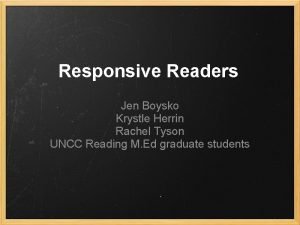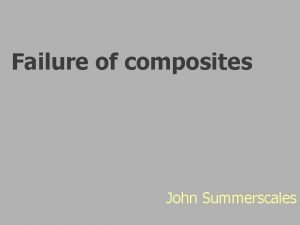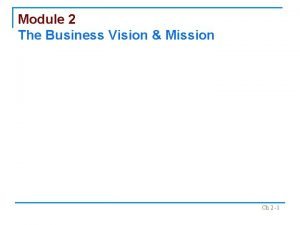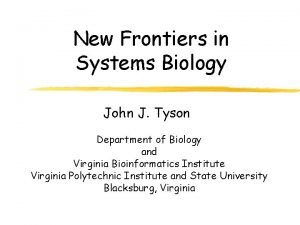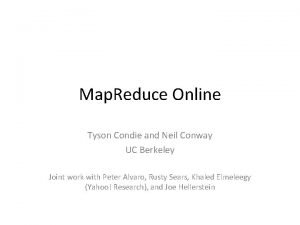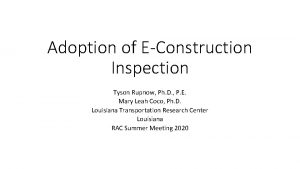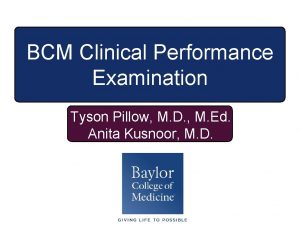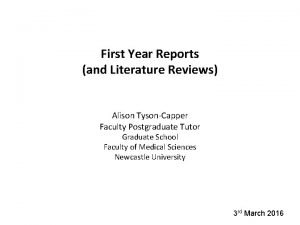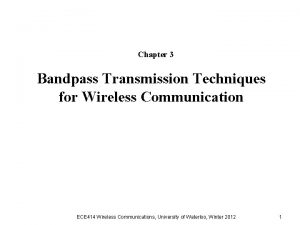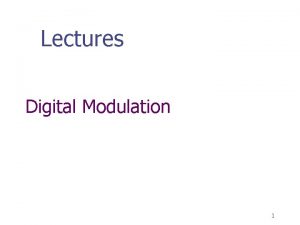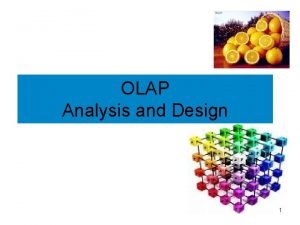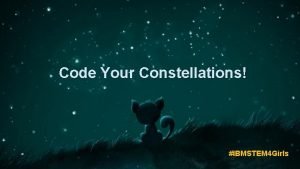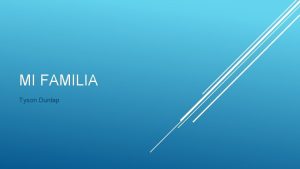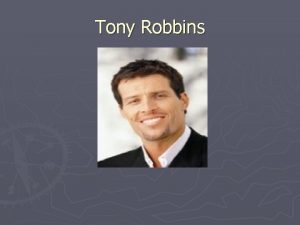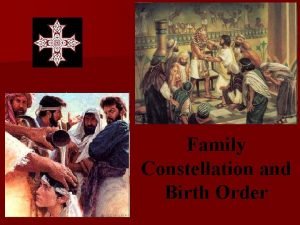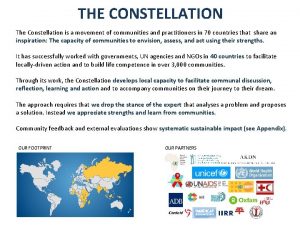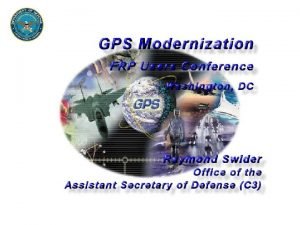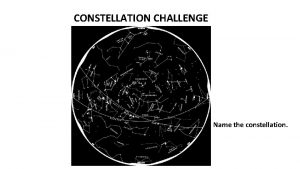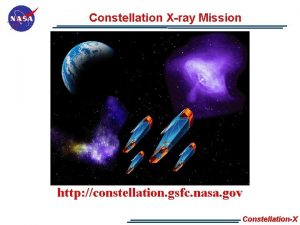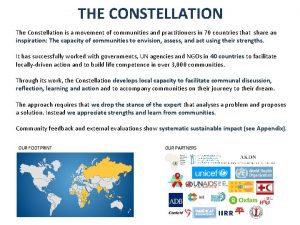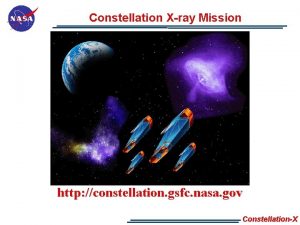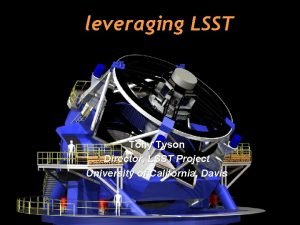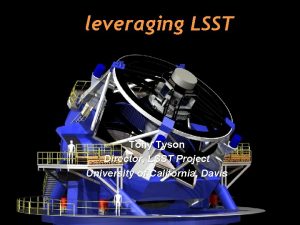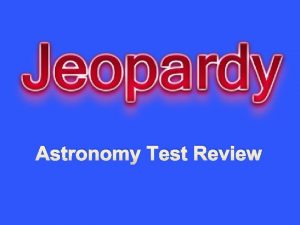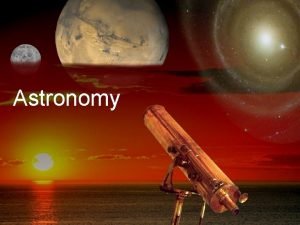Update Satellite Constellation Risk to Astronomy Tony Tyson



















- Slides: 19

Update: Satellite Constellation Risk to Astronomy Tony Tyson University of California, Davis Chief Scientist, Vera C. Rubin Observatory BPA November 19, 2020

Findings and Recommendations Based on SATCON 1 Workshop Report (from AAS-SIA webinar Oct 21 2020) AAS Staff: Joel Parriott (Public Policy Director) Kelsie Krafton (Bahcall Public Policy Fellow) SATCON Co-Chairs: Jeffrey Hall (Lowell Observatory) Connie Walker (NSF’s NOIRLab) SATCON 1 Working Group Chairs: Lori Allen (NSF’s NOIRLab) Pat Seitzer (U. Michigan) Tony Tyson (Vera Rubin Observatory) Richard Green (Steward Observatory) 2 Image credit: Pete Marenfeld (NSF’s NOIRLab)

SATCON 1 Technical focus SATCON 2 Policy & regulation focus ~late Q 1 2021 3

Impacts on Scientific and Observational Programs Rare Transients • Fast Transients • Searches for optical or infrared counterparts to fast transients require rapid responses. (Rubin Obs. LSST, ZTF, Pan-STARRS) • Satellites can ruin detections of these events. As they fade very rapidly, the ability to re-acquire the data is lost. • Optical Graviational Wave Follow-Up • Simultaneous data from optical/IR observatories and detectors, such as neutrinos or gravitational waves (GW), represent a unique multi-messenger science opportunity in the next decade. • Satellite trails interfere with algorithms developed to distinguish real transient events from false detections. • Rapid Contiguous Monitoring of Special Sky Areas • Several LSST science programs involve rapid contiguous monitoring of special fields. • This precludes satellite avoidance strategies where one moves to an adjacent field. 4

Impacts on Scientific and Observational Programs Deep, Wide, Extragalactic Imaging • Low surface brightness imaging surveys over wide areas enable unprecedented probes of cosmology and galaxy evolution. • For the Vera Rubin Observatory's survey (LSST), measuring the physics of dark matter & dark energy requires billions of extremely faint galaxies for which the shape must be accurately known to 1 in 10, 000. N • Science discoveries from these measurements will be more affected by systematics than by sample size. • Masked trails can potentially produce cosmic shear bias (e. g. , systematic error). • Virtually the entire astronomical community will rely on the released LSST data products. 5

Impacts on Scientific and Observational Programs Imaging of Large Extended Low Surface Brightness Targets • Galaxy surveys require very deep imaging consisting of long exposures & stacking those for the required depth. • High-redshift galaxies are 2– 100 million times fainter (Vmag ~ 23– 27) than a Vmag = 7 satellite. • Satellites can affect images up to 60 or more pixels away from the trails (or +/- 15 arcsecs). • Bright (Vmag < 12) image artifacts can make it difficult to detect faint galaxies. Count of the number of satellite trails affecting a 10 -second exposure for increasing field of view (FOV). The dots represent a series of direct simulations of observations, while the line shows a model fit. Credit: Galadi, private communications 6

Impacts on Scientific and Observational Programs Discovery of New Phenomena “Astronomy is still driven by discovery. ” (New Worlds, New Horizons — 2010 Decadal Survey of Astronomy and Astrophysics) • The most exciting and important science to come out of current and planned astronomical facilities will be the discoveries of types of objects and phenomena not yet observed nor predicted by theorists. • Those discoveries have the potential to revolutionize our understanding of every field from exobiology to cosmology. • For Rubin Obs. and other observatories, it is precisely this discovery space that is most at risk from artifacts arising from tens of thousands of LEOsats. Vera C. Rubin LSST Camera 7

Impacts on Scientific and Observational Programs Deep Multi-object Spectroscopic Surveys • Spectroscopic observations generally cover smaller fields of view than imaging programs. However, exposure times can be much longer for spectroscopy. • It is not known a priori which observations are contaminated, forcing a repeat exposure or possible loss of science opportunity. • There are several large spectroscopic facilities nearing operation or in advanced planning that are all vulnerable to LEOsat trails. (DESI, 4 MOST, MSE, ELT, GMT, TMT) • LEOsats leave a much wider trail than the effective size of low surface brightness objects. This impacts the necessarily long integration times for these faint objects. • Owing to the long exposure times, there is no mitigation for the next generation of large spectroscopic facilities. Control of mid-exposure shuttering is not possible. • Need to develop the ability to access the positions of the satellites with a precision comparable to a fiber diameter, and with a timing accuracy of ~1 second. 8

Click to a dd text Findings These LEOsats are bright: ~10 billion times brighter the than astronomical objects being studied. Many optical astronomy research programs would harmed. • In particular, sensitive wide field of view survey instruments (e. g. , Rubin Observatory's LSST), and low elevation studies (e. g. , near earth objects). • Once the number of bright LEOsats reaches the ~10, 000 range, the harm becomes severe. T. Tyson, Rubin Obs. Satellite visibility at Rubin Obs. P. Yoachim (UWash) Lower altitudes are generally preferable, even though those projects typically have more satellites. P. Seitzer, UMich 9

Findings Fly Low. Orbits < 600 km are strongly desirable to reduce satellite visibility. Lower orbits will also increase de-orbit efficiency and timescale. P. Seitzer (U. Michigan) 10

Potential Mitigations 1. 2. 3. 4. Fly fewer Fly lower (ideally <= ~600 km) Reduce brightness (darken satellite) Minimize reflective area during orbit raise/lowering via attitude control 5. Remove and/or mask trails in images 6. Improve ephemerides Starlink's Dark. Sat (black) was measured to be ~2. 5 times fainter than its four undarkened siblings launched in January 2020. (Tyson et al. 2020)

Recommendations Three categories. 1. For observatories 2. For satellite operators 3. For observatories and operators in collaboration 12

Recommendations 1 -3: For Observatories 1. Create more robust software tools for trail masking and removal. 2. Create more robust predictive tools for satellite transits. 3. Better understand systematics of trail-masking on resultant images. T. Tyson, Rubin Obs. 13

Recommendations 4 -7: For Operators 4. Incorporate thorough BRDF measurements in satellite design. 5. Design for fainter than 7. 0 V mag +2. 5 × log(rorbit / 550 km), equivalent to 44 x (550 km / rorbit) watts/steradian. Dark. Sat (Space. X) Visor. Sat (Space. X) 14

Recommendations 4 -7: For Operators 6. Minimize specular reflection in the direction of observatories. Provide accurate timing guidance for flares that may occur. 7. Clump satellites post-launch while in parking orbits. Use attitude adjustment to minimize reflecting surface area as seen from ground tracks. Victoria Girgis (Lowell Observatory) 15

Recommendations 8 -10: For Observatories and Operators Collaboratively 8. Create a comprehensive satellite observing network (incl. citizen science). 9. Greatly improve (~10 X) publicly available positional information. 10. Adopt a new standard format for ephemerides beyond present TLEs. 16

Concluding Remarks • With the exception of spectrum managers at radio astronomy observatories who follow satellite industry developments and FCC proceedings, most individual astronomers and institutions are only now coming to appreciate fully the magnitude and complexity of the problem. • The main organizational stakeholders in research astronomy appreciate the economic, societal, and geopolitical benefits of these LEOsat constellations and we want to work in partnership with manufacturers and operators (both established and startups) to mitigate the impacts on our government- and philanthropistfunded research programs. • Decision making in academia tends to move much slower than in the satellite sector, and securing funding agency grant support to realize observatory recommendations is even slower. 17

Concluding Remarks, cont'd • At this time, there is not a one-stop shop for industry partners to engage/consult/test as they develop and refine systems, but we're working on it. In the interim, the professional societies (IAU, AAS, RAS, EAS and IAU) have stepped into the void, as well as major observatories. • In the US, the primary mechanism for significant new programs (e. g. , instrumentation R&D, monitoring observatory network, etc. ) at the National Science Foundation comes from the National Academies' "decadal survey" (next astronomy-focused report due summer 2021). • We hope that the SATCON 1 and SATCON 2 workshops, along with the Dark and Quiet Skies workshop, will help get things started. 18

Recent events: toward wider engagement • Discussions with Amazon Kuiper and One. Web • Dark & Quiet Skies workshop (UN Office of Outer Space Affairs): https: //www. unoosa. org/oosa/en/ourwork/psa/schedule/2020_dark _skies. html • UN Committee on the Peaceful Uses of Outer Space (COPUOS) report
 Learning astronomy by doing astronomy activity 1 answers
Learning astronomy by doing astronomy activity 1 answers Learning astronomy by doing astronomy
Learning astronomy by doing astronomy Learning astronomy by doing astronomy activity 1 answers
Learning astronomy by doing astronomy activity 1 answers Recovery techniques based on immediate update
Recovery techniques based on immediate update Market risk credit risk operational risk
Market risk credit risk operational risk Rachel tyson
Rachel tyson Kelly tyson
Kelly tyson Mission statement for school
Mission statement for school John j. tyson
John j. tyson Tyson conway
Tyson conway Tyson
Tyson Red delicious% apple
Red delicious% apple Tyson pillow md
Tyson pillow md Alison tyson xxx
Alison tyson xxx John j. tyson
John j. tyson Ask modulation constellation diagram
Ask modulation constellation diagram Qpsk constellation diagram
Qpsk constellation diagram Star constellation schema
Star constellation schema Little dipper and big dipper
Little dipper and big dipper Find constellation
Find constellation





